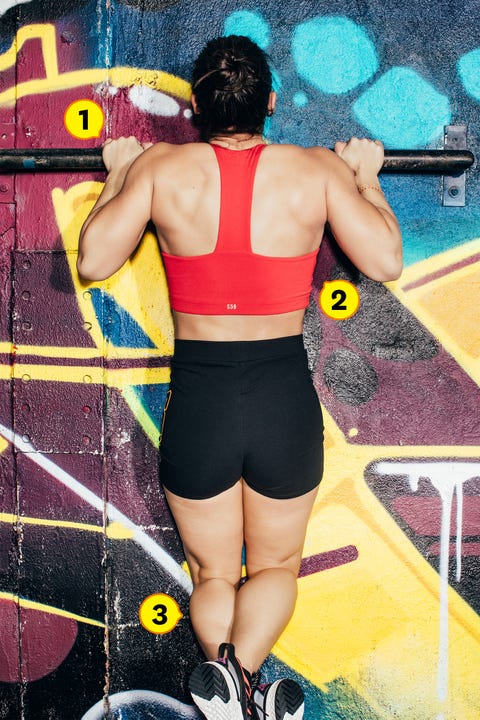Even if you’re practically a fitness pro, you may still use “chinup” and “pullup” interchangeably to mean the same intense upper-body exercise. But, it turns out, they’re not synonyms after all.
Still, they are related. In fact, a chinup is actually a variation of a pullup, says Doug Sklar, CPT. “Both involve pulling your body up until your chin passes a bar,” he says.
So, how are chinups and pullups different? It’s in the subtleties of the move, and your hands. “A chinup involves the palms of your hand facing toward you, while a pullup would have your palms facing away from you,” he says.

Meet the experts:
Doug Sklar, CPT, is the owner of Philanthrofit and a running and obstacle race coach. Angela Gargano, CPT, is an American Ninja Warrior with speciality pullup programs through Strong Feels Good. Albert Matheny, CSCS, is a certified strength and conditioning specialist, cofounder of SoHo Strength Lab, and founder and CEO of Promix nutrition for athletes.
How you space out your hands on the bar is also different. Pullups generally involve a hold that’s slightly wider than shoulder-width, Sklar says. While “chinups are typically performed with a narrower grip, approximately shoulder-width,” says Sklar.
Want to hang out and learn why pullups and chinups are so worth the effort? I thought so, here’s a comprehensive guide to both moves and how to master them, all according to trainers.
What are the benefits of chinups and pullups?
Since chinups are technically a pullups variation, as you might have guessed, the perks of both are basically the same. “There are so many benefits, not only physically, but mentally, which is why I am so passionate about them,” says Angela Gargano, CPT. “It’s a functional movement that creates strength in a natural way using minimal equipment.” Here are the big perks of chinups and pullups:
- Strong biceps. The big difference is that chinups work your biceps a little more, while pullups are usually more challenging as a whole, says Albert Matheny, certified strength and conditioning specialist.
- Better posture. Both moves target your lats more than other back exercises like rows, according to research from the American Council on Exercise.
- Serious grip strength. “It’ll come in handy for anything that involves holding dumbbells or barbells too,” says Gargano. And even though these are challenging exercise, they’re actually not hard in one very important way: It’s low-impact and easy on your joints and tendons.
- Level up all your workouts. The muscles and control you’ll build in pursuit of hoisting your chin above the bar will also help make other drills that target the same areas feel breezy (or at least less freakin’ tough).
- Pullups and chinups create defined muscles. You’ll feel and start to look like Wonder Woman. Both exercises sculpt your bod in ways few other moves can, says Gargano.
Improve your pullup form:
- Keep your hands close to your shoulders.
- Engage lats by thinking about drawing them down toward hips.
- Don’t let lower body swing back and forth or tuck knees toward chest for extra oomph.
Nail your chinup form:
- Don’t jut your chin out to eek it over the bar. (It’s bad for your neck!) Instead, keep it slightly tucked so the back of your spine stays long.
- Position hands slightly wider than shoulders.
- Engage abs the. whole. time.
This content is imported from poll. You may be able to find the same content in another format, or you may be able to find more information, at their web site.
What muscles do pullups and chinups target?
These moves are excellent for firing up muscles all over your bod. That’s why they feel so challenging. “A lot of muscles are activated when performing a pullup or chinup,” Sklar says. You’re engaging pretty much your entire upper body and core.
The major muscles worked in pullups and chinups: latissimus dorsi (aka lats, the big back muscle), pecs, biceps, deltoids, forearms, and core
You might be surprised to feel much more than your arms burning when you bust out a few reps. “In fact, pullups/chinups are one of the best abs exercises you can do,” says Sklar.
7 Variations To Master Pullups Or Chinups
They’re pretty incredible, but it’s time for a quick reality check. Truthfully, achieving your first pullup or chinup is hard and time-consuming–it can take anywhere from two weeks to two months, says Gargano. It all depends on where you start from fitnesswise, and how much time and effort you dedicate to gliding over that bar.
It’s totally worth hanging in there. “After thinking it’s never going to happen, one morning you’ll wake up and discover you can finally do it,” says Gargano. “That feeling is empowering, liberating, and confidence-building.” So if you’re ready to join the movement, step—er, pull—right up.
These key moves will help you work your way to a full pullup or chinup. (Put ’em together with the doable, all-levels training plan below, programmed by Gargano.)
Passive Hang
Grip bar with arms straight and palms facing forward, hands just outside shoulders, body fully relaxed. Hang as long as possible (i.e., your max)—ideally, at least 30 seconds.
Active Hang
From a passive hang, engage lats and shoulders to draw tops of arms slightly down and away from ears, keeping arms straight and shoulder blades wide. Hold at least 30 seconds.
Shoulder Shrug
From a passive hang, engage lats to roll shoulder blades back and down, raising body toward bar. (It’s a small movement!) Return to start and repeat. Keep body straight while elevating/lowering.
Flexed Arm Hang Series
From a passive hang, lift body a quarter of the way up to bar and hold for 30 seconds. On second attempt, go halfway up. The third time, try to get chin above bar.
Eccentric Pullup
Start at the top of the pullup motion (jump or use step), then lower body as slowly as possible into a passive hang, keeping core engaged and shoulders relaxed the entire time.
Moving Around Bar
From a passive hang, keep shoulders relaxed as you walk hands side to side across bar (ya know, like you did as a kid on the monkey bars) for 30 seconds.
Assisted Band Pullup
Loop resistance band around bar and place loose end under one foot. Stack other foot on top. Passively hang from bar, then en-gage core, lats, and glutes to perform a full pullup. Slowly lower back down with control.
Your Weekly Pullups Training Program
Warm up your shoulders, then do one set of each exercise back to back—no breaks. Rest for 45 seconds, then go for another round.
- Day 1
- 1 unassisted pullup (UAP) attempt, filmed
- 3 x max passive hang
- 3 x 10 shrugs
- 3 x max flexed arm hang series
- Day 2
- 3 x 30 seconds passive hang
- 3 x 10 shrugs
- 3 x max flexed arm hang series
- Day 4
- 1 UAP, filmed
- 3 x 30 seconds active hang
- 3 x 10 shrugs
- 3 x 5 eccentric pullups
- Day 5
- 3 x 30 seconds active hang
- 3 x 30 seconds moving around bar
- 3 x 10 assisted pullups
- Day 6
- 1 UAP3 x 10 shrugs
- 3 x 30 seconds flexed arm hang series
- 3 x 30 seconds moving around bar
- Day 7
- Bust out as many full pullups (or chinups) as you can, either un-assisted or with a resistance band. You’ve got this!

